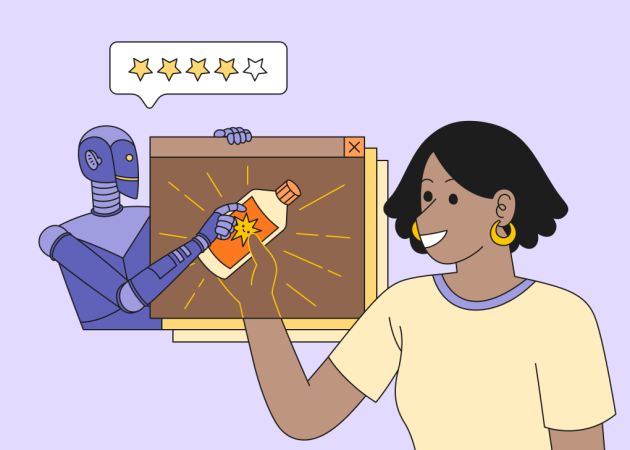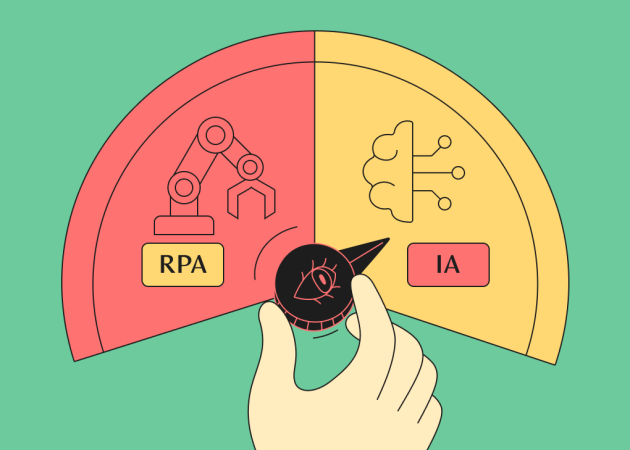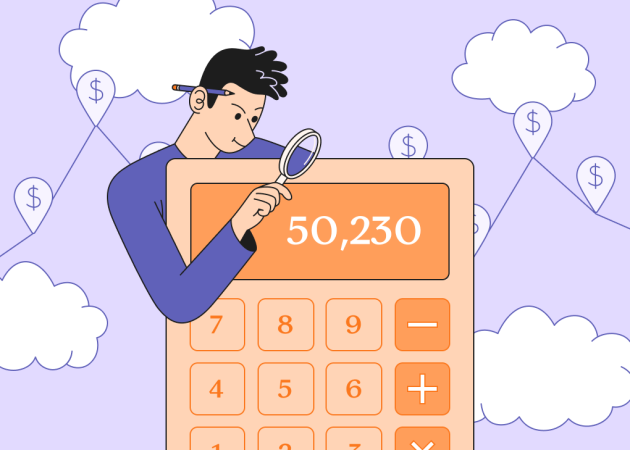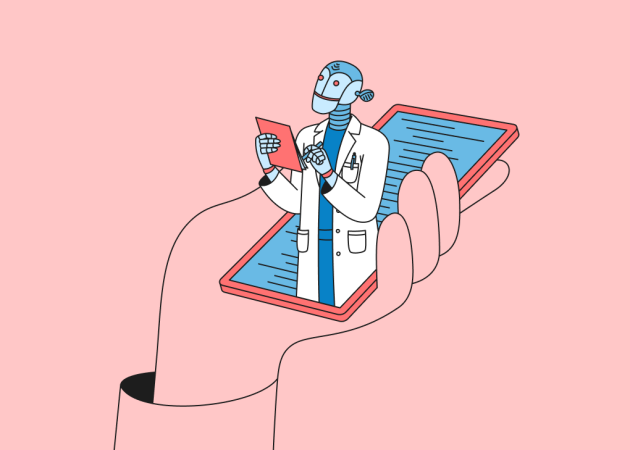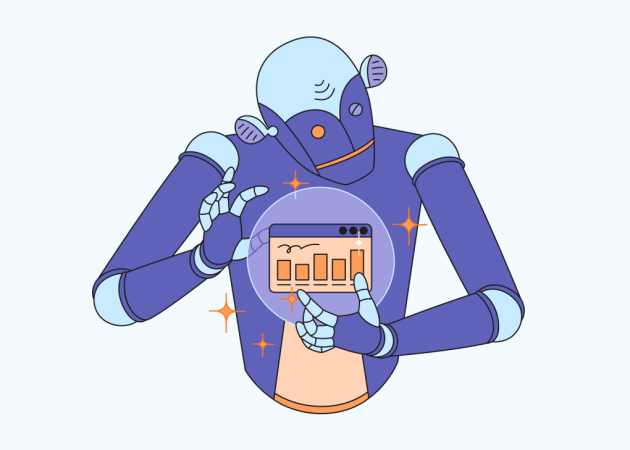
From Data to Deals: How AI in Marketing Fuels Customer Acquisition
Contents
Contents
Acquiring new customers has always been one of the biggest challenges in business, and also one of the most expensive. As competition intensifies and customer expectations evolve, traditional marketing methods often fall short. That’s where AI for customer acquisition comes in, and where smart, conversational tools like AI chatbots can turn everyday interactions into measurable business value.
AI in marketing is changing the way companies attract, engage, and convert new customers. It can predict which leads are most likely to buy and personalize outreach for each audience at scale. By turning data into clear, actionable insights, AI helps marketing teams make faster, smarter decisions that lead to real, measurable results. In this article, we’ll explore how AI streamlines every stage of customer acquisition, helping businesses lower costs, improve targeting, and build stronger relationships with their audiences.
How AI in Marketing is Transforming Customer Acquisition
According to McKinsey, generative AI could boost marketing productivity by 5–15% of total marketing spend or roughly $463 billion annually. For customer acquisition, this means marketers can direct more resources toward high-performing channels and reduce wasted spend.
Using AI for lead generation enables teams to analyze intent, predict behavior, and adjust campaigns in real time, improving both conversion efficiency and return on investment. Instead of targeting broad segments, you can focus on leads most likely to convert, turning marketing from a cost center into a growth driver.
Predictive Lead Scoring (Focusing on the Right Leads)
Predictive lead scoring applies AI and machine learning to identify prospects who are most likely to convert. Traditional scoring models often rely on a few manual rules, such as industry or job title, but AI goes deeper. It evaluates historical data and continuously learns from new outcomes to recognize the patterns that lead to a sale.
AI-driven models typically assess a wide range of signals, including:
- Behavioral data: page visits, content downloads, demo requests, and engagement frequency
- Demographic and firmographic factors: company size, role, industry, and market segment
- Intent and interaction trends: email responses, ad clicks, or social media engagement
- CRM and sales data: past opportunities, deal size, and conversion timelines
AI combines these data points and ranks leads by their likelihood to buy and updates the score dynamically as new information appears. This allows marketing and sales teams to align on priorities, tailor messaging to each lead’s stage in the journey, and reduce time wasted on low-value prospects. Over time, the model improves its accuracy, creating a self-optimizing system that keeps acquisition efforts sharp, efficient, and data-driven.
Hyper-Personalization with AI for Lead Generation
Hyper-personalization uses AI to create marketing experiences that feel unique to each customer. Machine learning looks at real-time data such as browsing habits and engagement patterns to understand what every person wants or is interested in. This helps marketers send messages that feel relevant and connect with what each customer actually needs or cares about.
Traditional personalization relies on basic demographic details while AI continuously refines its understanding as new data appears. It can detect subtle behavioral changes and adjust content, tone, or timing automatically. This adaptability allows campaigns to stay relevant even as customer interests shift.
For AI lead generation, hyper-personalization means turning mass outreach into one-to-one engagement at scale. By anticipating what potential customers want next, AI helps build trust earlier in the relationship and increases the likelihood of conversion. Over time, this approach changes how businesses attract and nurture leads. Static campaigns are replaced with dynamic systems that learn and improve with every interaction.
AI-Optimized Advertising
AI has transformed advertising from a reactive process into a continuously learning system. Instead of manually adjusting budgets or targeting rules, marketers can rely on AI to interpret massive datasets in real time and make data-driven adjustments automatically. This shift helps businesses use their ad spend more effectively, improving reach, engagement, and return on investment.
AI-driven advertising platforms work across multiple dimensions to refine performance:
- Audience targeting: identifying high-intent prospects by analyzing behavioral signals, purchase history, and lookalike audiences across platforms.
- Creative optimization: generating and testing variations of visuals, headlines, and copy to learn which combinations attract the most attention or drive conversions.
- Bid and budget management: dynamically adjusting bids and reallocating budget toward top-performing campaigns or audience segments.
- Channel and device optimization: placing ads across the channels, formats, and devices where target audiences are most active and engaged.
- Performance prediction: using historical and contextual data to forecast outcomes, helping marketers plan future campaigns with higher confidence.
- Brand safety and sentiment monitoring: detecting irrelevant or risky placements and ensuring ads appear in suitable contexts.
Together, these capabilities make advertising more efficient, adaptive, and accountable. Campaigns can react instantly to market trends, personalize engagement at scale, and continuously improve based on feedback loops.
Intelligent Content Generation with AI
AI in marketing and sales is changing the way teams plan, create, and distribute content across the customer journey. What once required days of manual effort, from drafting blog posts to writing ad copy can now be done in minutes with AI-powered tools that generate, summarize, and adapt content for different audiences and platforms. This amplifies human creativity by removing repetitive tasks and allowing marketers to focus on strategy and storytelling.
Intelligent content generation goes beyond simple text creation. AI tools now help teams:
- Produce multi-format content: generate blog articles, social media posts, product descriptions, and video scripts optimized for tone, length, and platform.
- Personalize messaging: adjust content for different audience segments or stages of the buyer journey to keep it relevant without having to rewrite everything.
- Repurpose existing assets: turn long reports into summaries, transform webinars into articles, or create short posts from internal materials.
- Maintain brand consistency: automatically apply your brand’s tone, voice, and style across all marketing channels and materials.
- Enhance SEO performance: find the right keywords, optimize titles and headings, and suggest metadata that matches user intent and current search trends.
- Analyze engagement data: track which types of content perform best and use those insights to improve future content and strategy.
When used strategically, generative AI services become a creative partner that helps teams scale content production without sacrificing quality or authenticity. They enable marketers to produce a continuous stream of targeted, high-performing materials that support lead generation with AI and nurture prospects through every stage of customer acquisition.

Churn Prediction Using AI for Customer Retention
Acquiring customers is important, but retaining them determines long-term success. AI-powered churn prediction helps businesses see when a customer might lose interest before they actually leave. By studying behavior patterns, purchase habits, engagement levels, and even tone in messages or reviews, AI can spot small changes that suggest a customer is becoming unhappy or less engaged.
When AI detects signs that a customer might leave, marketing or support teams can act quickly with personalized offers, friendly check-ins, or content that sparks renewed interest. Since AI keeps learning from new data, its predictions get better over time, helping teams respond earlier and more effectively.
Ultimately, churn prediction closes the loop between acquisition and retention. It turns customer management from a reactive task into a proactive strategy that helps businesses protect revenue, build loyalty, and increase the lifetime value of every customer.
How to Get Started with AI for Customer Acquisition
Implementing AI for lead generation doesn’t have to be overwhelming. The key is to start small, build on what already works, and make data your foundation. By taking a strategic approach to AI adoption — setting clear priorities, defining measurable goals, and working with the right partners — businesses can see results quickly while building a solid base for long-term growth.
Audit Existing Data and Systems
Before introducing AI, evaluate the data it will depend on. Map all customer-related sources, such as CRM records, website analytics, email engagement, purchase histories, and support interactions and assess their accuracy, completeness, and consistency. Even small gaps or duplicates can distort how AI models interpret customer behavior and predict outcomes. This audit also helps identify which datasets are most valuable for lead scoring, segmentation, or personalization.
Next, review your current tools and infrastructure to ensure they can support AI integration. Some platforms may already include automation features or APIs that simplify adoption, while others might need updates or data cleanup. Make sure your data is easy to access, well protected, and meets privacy rules like GDPR. Getting this right early creates a solid base for your AI tools to work effectively and makes future implementation much smoother.
Identify Quick Wins
After your data is in good shape, look for areas where AI can make a clear, noticeable impact right away. Focus on processes that already collect useful data but still depend on manual work, like lead scoring, ad targeting, or email personalization. Adding AI here can quickly show real value, save time, and build support for using it more widely.
These early wins don’t require big investments or major technical changes. Start with pilot use cases that can show clear outcomes, like higher click-through rates or improved lead quality, within a few weeks. Early success creates momentum, allowing your team to learn from real results and scale AI initiatives with confidence and strategic alignment.
Select the Right Tools or Partners
Choosing the right tools is key to getting real results from AI lead generation software. Look for platforms that connect easily with your current systems, can grow with your business, and are clear about how their algorithms work. Prioritize approaches that address specific acquisition challenges, like predictive analytics solutions or campaign optimization rather than those offering broad, undefined “AI capabilities.” The right choice should align with your goals, team skillset, and available data.
If your internal resources or expertise are limited, partnering with an experienced AI or data consultancy can accelerate adoption and reduce risk. Our developers can support organizations at any maturity level, from strategic advisory and MVP development to full-scale implementation. This kind of collaboration ensures a faster start, smoother integration, and knowledge transfer that helps your team sustain and expand AI initiatives confidently over time.
Run Pilot Projects Before Scaling
Before fully deploying AI across your marketing and sales operations, start with a focused pilot project. Choose one use case, such as improving lead qualification or optimizing ad spend, and define clear success metrics. Running a pilot allows your team to test data pipelines, evaluate model accuracy, and understand how AI integrates with daily workflows without disrupting existing processes.
Use insights from the pilot to refine your approach before expanding to other areas. Document what worked, what didn’t, and how outcomes align with your business goals. Once the model proves effective and stakeholders see tangible results, you can scale adoption across channels and departments with confidence.
Building a Smarter Path to Customer Growth
AI helps businesses focus on what matters most, from finding the right leads and personalizing outreach to improving ads and keeping customers loyal. But using AI well is not about moving fast. It is about having a clear plan, choosing the right tools, and scaling step by step. Whether your organization is just beginning to experiment with AI or already building advanced marketing capabilities, we can meet you where you are. We support teams at every stage of their AI journey, from early exploration and advisory to hands-on implementation. If you’d like to discuss how AI customer acquisition could boost your strategy or uncover new growth opportunities, feel free to reach out.
FAQs
Can small businesses use AI for customer acquisition?
Yes. Many AI tools today are accessible and affordable for small and midsize businesses. They can automate lead generation, personalize marketing messages, and analyze customer behavior with minimal setup. For example, custom AI chatbots, predictive analytics, and email personalization platforms help small teams attract and convert leads more efficiently without large marketing budgets.
What is the difference between AI marketing and marketing automation?
Marketing automation works based on predefined rules. For example, it might automatically send a welcome email after someone signs up. AI in marketing automation, however, uses machine learning to make decisions in real time, learning from data to adjust messages, timing, and targeting for better results.
It can predict which leads are most likely to convert and personalize campaigns based on each user’s intent instead of fixed rules. Unlike traditional automation, AI keeps learning from new data, improving its predictions and performance over time. This helps marketers react faster and more accurately to changes in customer behavior and market trends.
Is AI for customer acquisition expensive?
Not necessarily. While enterprise-level AI systems can be costly, most modern solutions are scalable and subscription-based. Cloud-based platforms, APIs, and AI integrations in CRM or advertising tools let businesses start small and expand as they see results. Many tools also offer flexible pricing tiers, making them accessible even to smaller teams. The long-term ROI often outweighs initial costs by improving targeting accuracy, reducing wasted ad spend, and freeing up time through automation that would otherwise be spent on manual data analysis or campaign management.
How does AI help reduce customer acquisition cost?
AI helps businesses identify high-value prospects early, optimize ad placements, and personalize outreach at scale. Predictive analytics prevents spending on low-quality leads, while automation reduces manual marketing tasks. Together, these capabilities improve conversion rates and maximize the efficiency of every dollar spent on acquisition.
Which AI tools for lead generation are the most effective?
The most effective tools depend on your goals and channels. For outbound marketing, tools like Apollo.io and ZoomInfo use AI to find, score, and qualify leads with greater precision. For inbound customer acquisition AI strategies, HubSpot, ActiveCampaign, and Marketo use tools to personalize email sequences, segment audiences, and improve nurturing workflows. In ad optimization, platforms such as Google Ads, Meta Ads Manager, and AdRoll integrate AI to automatically allocate budgets toward high-performing audiences and refine targeting based on real-time engagement data, boosting overall campaign efficiency and lead quality.
Subscribe to blog updates
Get the best new articles in your inbox. Get the lastest content first.
Recent articles from our magazine
Contact Us
Find out how we can help extend your tech team for sustainable growth.
